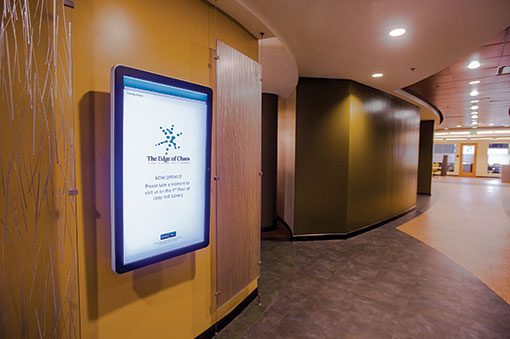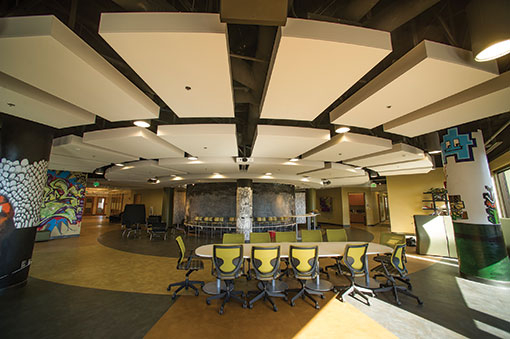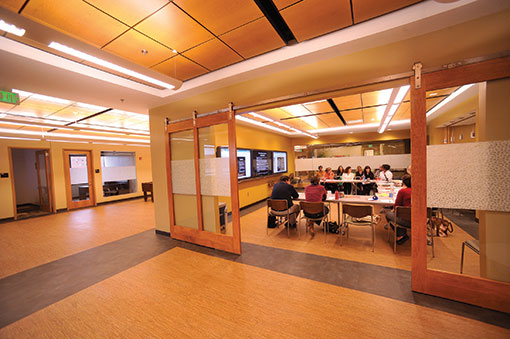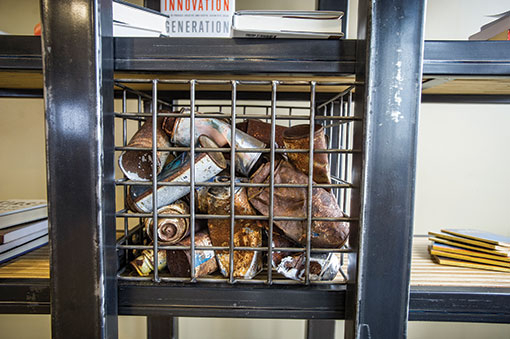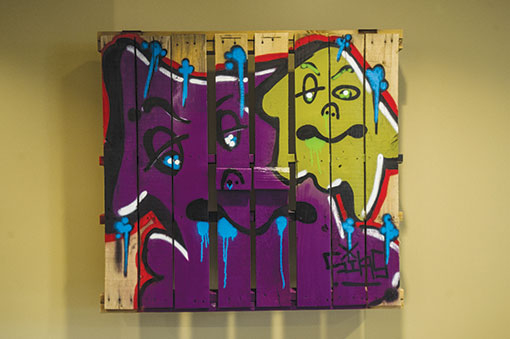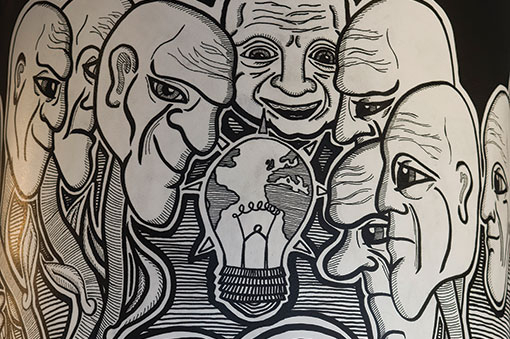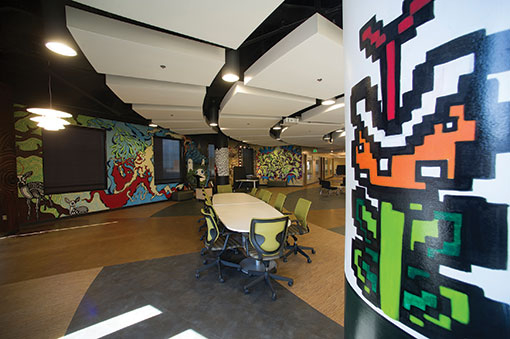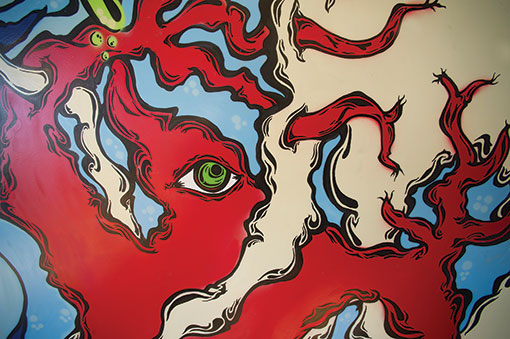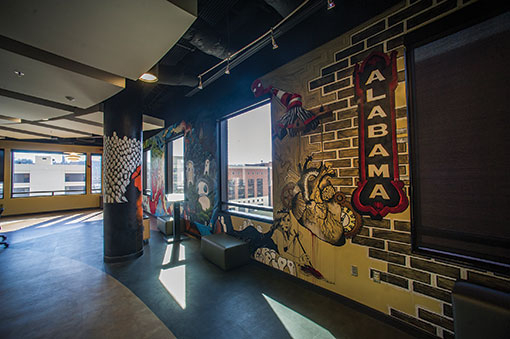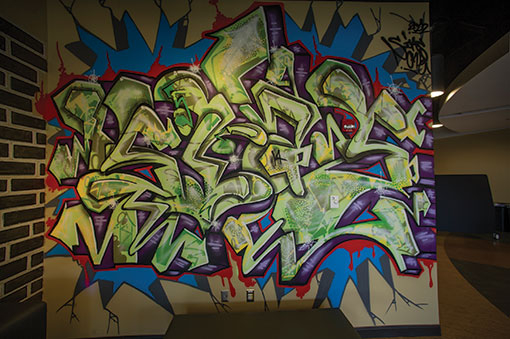Creating Innovation through Chaos
By Jo Lynn Orr
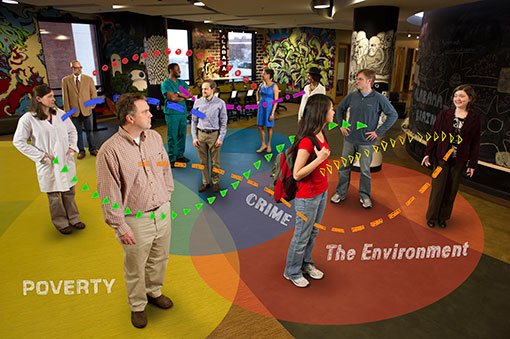
Wondrous things can happen in the narrow space where order and disorder meet. Chaos theory, which explores this elusive edge, offers insights into the behavior of everything from Wall Street to the local weather. Max Michael, M.D., dean of the UAB School of Public Health, is convinced that a dose of chaos could benefit another complex system: academia.
On the fourth floor of Lister Hill Library, Michael has assembled a free-form think tank with spacious gathering areas, movable furniture, and a coffee shop—all designed to generate unforeseen interactions and spark creative thinking among researchers from all across campus.
Michael’s brainchild, dubbed The Edge of Chaos, was inspired by Steven Johnson’s recent book Where Good Ideas Come From: The Natural History of Innovation. “Ideas flourish, according to Johnson, where there is openness and collaboration rather than competition and efforts to protect and isolate concepts,” Michael explains. “He uses the phrase ‘adjacent possible’ to explain how ingenious concepts often open new paths to explore.”
Unexpected Insights
One story from Good Ideas that captured Michael’s attention involved the construction of infant incubators in rural India. “In the United States, broken state-of-the-art incubators can easily be repaired by having hospital personnel identify the problem and install the replacement parts,” Michael says. But in the Indian country-side, where parts and trained personnel are hard to come by, “that repair model simply doesn’t work,” and incubators are often out of commission, making them useless in the fight against infant mortality.
Looking for a solution, a nonprofit group called Design Matters hit upon a flash of insight. While few in rural India can repair high-tech medical equipment, “they are highly skilled at repairing used and worn-out cars,” Michael says. So engineers “linked the need with the skill and built fully functional infant incubators from spare car parts, with headlight bulbs serving as the heating source.”
Michael is hoping to inspire similar flashes of insight at The Edge of Chaos, which was designed using many of the lessons on creative environments that Johnson highlighted in Good Ideas. (For Johnson’s personal tips of boosting creativity, see “Spark Notes.”) “It’s just incredibly exciting to see a space that I somehow helped inspire,” says Johnson, the author of several bestsellers on the history of innovative ideas, who was on hand for the grand opening of The Edge of Chaos in October 2012.
“It’s really striking, and it has the open-endedness that’s so important to these kinds of spaces.”
That’s why the facility includes inviting common areas and movable furniture, for instance. But it’s the people, rather than the layout, that will ultimately make The Edge of Chaos a success, notes Johnson. The facility is purposely designed to have little permanently assigned space so as to ensure a constant mix of occupants. The task is similar to the one faced by a curator at a museum, Johnson notes, “except that instead of curating it with paintings, you’re curating it with people, who will collide with each other in interesting ways.”
(Story continues beneath the slideshow)
Point Man for Chaos
The chief curator for The Edge of Chaos is UAB alumnus David Hooks, who holds the title of director of innovation and says his job description includes serving as a sort of roving facilitator. “More than 200 meetings took place at The Edge of Chaos between our soft opening in July and the end of the year,” Hooks says. “Part of my role is to sit in at some of these meetings and point out areas where we can build collaborations.”
The Edge of Chaos is particularly suited to “wicked problems,” says Hooks. These are “big issues with social, political, and emotional components that make them very difficult to solve”—such as transit, crime, the environment, and poverty, he explains. Hooks, who earned a master’s degree in public administration from UAB in 1992, has spent much of his career in politics and investment banking, building up a wide network of contacts in the Birmingham community. He has served as director of the Alabama Department of Economic and Community Affairs and head of industrial recruitment for the Tennessee Valley Authority, and spent six terms on the Homewood City Council.
“Community input will be a major source for the questions tackled at The Edge of Chaos,” Hooks says. That input will be generated both at in-person events like a series of “wicked lunches,” and in discussion forums at The Edge of Chaos website (www.theedgeofchaos.org), he explains. But simply generating ideas isn’t enough, Hooks adds. “My role is to take the intellectual output of this space and do something with it,” he says, “whether that be creating a product, advancing a solution for the public good, or handing that idea to someone else to carry forward.”
Michael envisions The Edge of Chaos providing fertile ground for insights in a host of fields. “I see The Edge as a place where faculty and students from different disciplines across UAB, as well as members of the community, can come together to participate in inventive discovery,” he says. “This will be a place where transdisciplinary thinking will be the norm and ideas will emerge.”
Spark Notes
Bestselling author Steven Johnson offers his personal tips on boosting creativity.
1. Online, Expand Your Social Network: "I've deliberately tried to assemble a diverse mix of people that I follow on Twitter. I follow about 150 people, and in that group are musicians, political writers, technology people, architecture critics. What I get out of them is very rarely the actual content of the tweet; it's the link to the article they've read, or a video, or to the blog post that they've written."
2. In Person, Expand Your Circle of Friends: "Martin Ruef did an amazing study about unusually innovative people and it turned out that the defining property of their real-life social networks was that they had connections to a diverse range of professions, whereas people who were less innovative only knew people in their own fields. Being able to extend the wealth of perspectives that you encounter just makes you smarter, and more original in your thinking."
3. Keep Track of Your Thoughts: "Most ideas take a long period to incubate. But our memories are finite. Hunches aren't fully formed, and so they're competing for hard-drive space in your brain. So I've had this practice that I've been doing for seven or eight years of writing it all down. I write down every single stray idea I have: ranging from ideas for startups to chapters of a book I'm working on, or an idea for an article. I put it all in one place and I don't organize it at all. It goes into one document, and this is the key thing, I try to re-read that whole document every four or five months. You re-encounter all these old ideas that you've totally forgotten."
